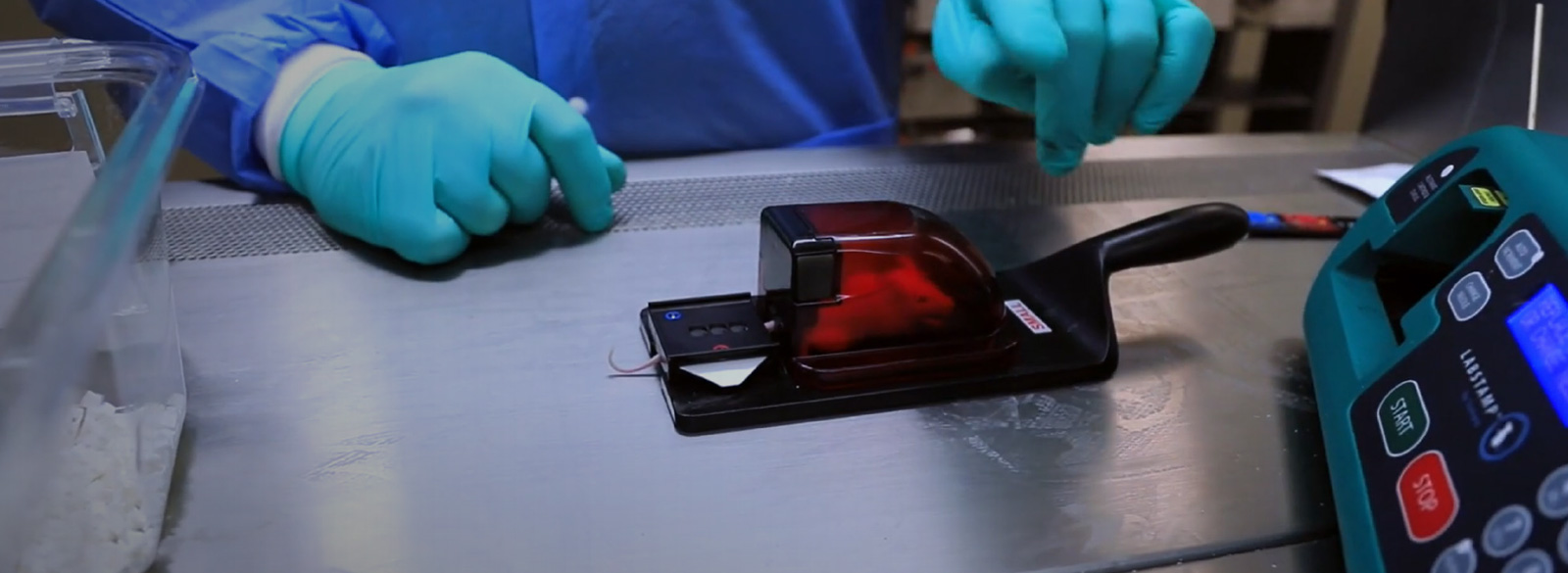
APPLICATIONS
Mouse Ear Tags VS Labstamp
COMPARISON
Mouse Ear Tags: Mouse identification
Ear tags for mice are a common, cost-effective solution for associating a unique identifier with a study subject.
Throughout the longevity of a preclinical research study, the behavior and appearance of a laboratory mouse or other animal must be monitored under regulatory protocols to produce enough risk assessment data to investigate the therapeutic value of a potential candidate on health.
All the data collected against an individual subject throughout this preclinical research stage must be historical and retrievable. The only way to achieve this is through identification which can take the form of ear tags for mice.
A mouse’s ear is made up of sensitive tissues which poses the risk of welfare and health implications for the subject. This not only raises regulatory and compliance concerns, but it can also distort the quality and integrity of research data.
An ear tag applicator for mouse subjects relies on the sensitive tissues resisting metallic formulated tags which typically have nickel components and are relatively heavy.
Are you questioning ear tags for mice?
Identification is an indisputable necessity for preclinical research until modern advancements produce an alternative method for the in-depth and complete assessment of the safety of new drug candidates.
Using a mouse’s ear as the sole basis and support for an identification method has posed questions regarding the animal’s welfare and the security of the identification method.
Our team of laboratory professionals and research experts have addressed some of the most obvious and common consequences of relying upon mouse ear tags during the crucial studies of preclinical research.
Given that these phases of the drug development journey can take years, it is pivotal that technicians and study managers assess their identification before the commencement of a study, mitigating any risks that the ear tag applicator for a mouse or the ear tag itself might cause.

Evidenced challenges to research, born from mouse ear tags
Ear tags for mice: Health
Metallic ear tags have a nickel compound which has been documented to cause a tissue reaction in certain strains which are typically used for medical research. Primarily, the FVB strain.
In a long-term study of incipient congenic FVB/N mice containing the human BCL6 transgene, the development of squamous cell carcinomas (SCCs) was reported on the skin at the site of the ear tags, which were composed of nickel-copper alloy.
As a result of the tags used for the study, 8.8% of the study mice developed SCCs in the tagged ear over an observation period of 25 months.
‘Nine of the fourteen mice with SSCs has to be euthanized because they were thought to be in distress from the ear condition’. This aspect of the use of ear tags for mice highlights compliance issues with the Three Rs of animal welfare. Where their use should be refined in all aspects if required.
For studies within the remit of anticancer therapies, blood inflammation biomarkers or behavioral studies, for example, the research data is not representative of healthy animals.
Baron BW, Langan G, Huo D, Baron JM, Montag A. Squamous cell carcinomas of the skin at ear tag sites in aged FVB/N mice. Comp Med. 2005 Jun;55(3):231-5. PMID: 16089170.
Ear tag applicator: Mouse Welfare
Going beyond their effects on health, ear tags in mice also pose several welfare concerns which can lead to longer-term health implications. For example, placing an object in the ear of a mouse can and will impact their ability to echolocate.
Given the confines of their cage within a research facility, this may seem inconsequential however, it can impact their core behaviours, cause stress and inevitably restrict their movement.
Further to this, the weight and shape of the ear tags in mice can often pull down the ear and cover the ear canal. Since mice communicate at such high frequencies, tagging effectively deafens the mouse in the respective ear. Although the behavioral impact of semi-deafness is not well observed, we believe it to be a welfare implication that can and should be avoided.
For reference, metallic mouse ear tags are heavy in comparison to the study subject. Comparing a 25gm mouse to the average weight of an ear tag (Xgm), it is analogous to a 3-pound dumbbell attached to the ear of a 250-pound adult human.

Mouse ear tags and data integrity
Aside from the obvious concerns that mouse ear tags raise regarding the health and welfare of the study subjects, they also implicate the integrity of data collected to a subject’s genetics, physiology, psychology, behavior and more, by not being the most accurate and appropriate methods of identification.
Ear tags can be difficult to read in general. In circumstances where the tags have not caused any health or welfare damage, the tags can often rotate 180 degrees from their initial placement. It’s not uncommon for tags to be misread, with 1861 being read as 1981 and many other potential instances of misidentification with numeric indicators.
Ear tissues are also very thin and can easily tear. Tagging is not the most absolute and permanent identification method available to today’s market. With routine scratching, cage mate fighting and other natural behaviors of the study subjects come exaggerated tears resulting in lost tags.
The welfare and data integrity problem: ear tags for mice
Labstamp’s permanent, tail tattoos
It is important that any researcher considers the consequences of the identification method they have chosen and prepare for the effects that this can have on compliance, welfare and research progressions.
One of the most dutiful actions a researcher can do to overcome the problems and challenges born from ear tags for mice is to opt for a different method from the offset.
Labstamp is an example of the tail tattooing method, which has been proven to overcome many of the challenges of ear tagging primarily from its ability to eradicate the need for a tag in the first instance.
Through permanent tattooing and a small application needle (21 gauge for Labstamp specifically), study subjects have their identifier applied once whilst the alpha-numeric tattoo lasts the lifetime of the study.
The tattoos are also much easier to apply, with Labstamp’s starter kit providing a safety restraint to minimize handling and an application speed of just 30 seconds. Making the tail the focal point of the identification rather than the sensitive ear tissue also offers more confirmation that the application and the ongoing management of the ID are relatively painless in comparison to tagging.
Overcome the problems associated with misidentification, whilst also prioritizing the welfare compliance of your research study in a bid to advance your drug candidate development journey.
